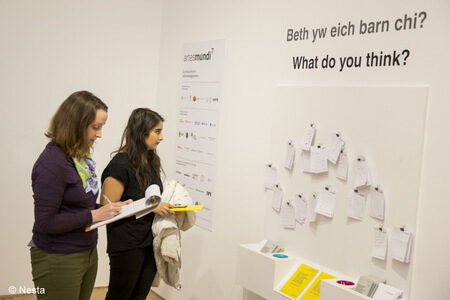“Until now museums and galleries have had only a limited understanding of their visitors – they need to build better audience relationships than they could achieve with a door counter alone. I’m very excited that iBeholder… offers a plausible solution to that challenge.” Chris Brown, Co-Director
Un-ticketed arts organisations are not able to capture much data about their audiences. As a result, their understanding of these audiences is limited, and their engagement, marketing, and programming is not as effective as it could be.
This was the challenge identified by g39 – an artist-led contemporary gallery based in Cardiff – and its partners. They wanted to create a tool that would help them, and others in the sector, learn more about and engage their audiences. Rather than simply aiming to harvest e-mail addresses or demographic data, they wanted to develop a two-way conversation that enhanced visitors’ experience and their knowledge of art while gathering information about their tastes.

After helping g39 to design an R&D project and win funding from the Digital Innovation Fund for the Arts in Wales, we worked as their business and innovation partner to deliver the project.
We used an iterative co-design process, starting with workshops with both gallery curators and potential users of the tool. This helped us to design a conversational approach that mimicked the interactions that staff and visitors actually have in galleries. This was important: rather than being about a technical challenge, we knew that the heart of the project was about creating an experience that was valuable to visitors.
A prototype built using WordPress allowed us to go through three rounds of beta testing with users at g39, Artes Mundi and Oriel Wrecsam. Our specialist in user-centred testing observed users interacting with the tool ‘in the wild,’ and then generated new insights that allowed us to alter and improve the tool with each round of testing.
Even during this process – at all stages from the ‘alpha’ workshops to the final beta test – the tool was generating new insights into audiences. Oriel Wrecsam learned that 31% of their exhibition visitors came simply because ‘I was walking past and it looked interesting.’ They also learned that 45% of visitors considered themselves mainly into popular culture – much higher than expected.
The project brought other immediate benefits to the arts partners. Their staff developed skills in good R&D practice alongside a whole new vocabulary relating to digital. They were introduced to principles of marketing, audience segmentation and psychometric profiling. They also explored new ways of authoring contextual material for their exhibitions.
Alongside g39, we launched the tool – newly named iBeholder – at the DIFAW showcase event in Cardiff on 14 March 2017.
We were also commissioned to provide business support for the project, creating the strategic road map and operational plan for the next phase of work: building the first version of the full product, wider user testing, and an initial market launch.
We are now actively looking for arts organisations (venues, commissioners, touring companies, ticketed and non-ticketed) to participate in this next phase – and for funding bodies, professional bodies and strategic partners who can support it.








